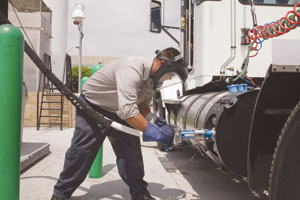Senior Reporter
Natural-Gas Advocates Claim Victories in Phase 2 GHG Emissions Regulation

This story appears in the Sept. 5 print edition of Transport Topics.
The Phase 2 greenhouse-gas emissions final rule gave natural-gas advocates victories in how the alternative fuel is handled and how emissions of methane are regulated, they said, even as the rule forecast little chance of natural gas becoming a major fuel source for heavy-duty trucks in the next decade.
The Environmental Protection Agency and the National Highway Traffic Safety Administration announced the final rule Aug. 16.
Asked if any of his member companies had expressed some concern the Phase 2 rule would negatively affect their business plans for expansion, Matt Godlewski, president of Natural Gas Vehicles for America, or NGV America, responded: “Unequivocally, no.”
“Speaking for our entire membership, we are pleased that we got a fair shake in this rulemaking. And there are going to be continuing opportunities based on the economics that are out there to use more natural-gas trucks,” Godlewski said, alluding to more costly emissions-control system slated for diesel-powered trucks.
EPA and NHTSA said in the rule they saw no need to make “fundamental changes” to Phase 1 of the rule’s oversight of natural-gas engines and vehicles.
“So we are comfortable leaving the regulations as they are. For us, having that consistency and certainty is a good thing,” Godlewski added.
The Washington-based Natural Gas Vehicles for America advocates for greater use of natural gas as a transportation fuel.
One key concern with the rule, however, rests on how it will affect small businesses that take diesel vehicles and convert them to natural gas, Godlewski said.
“It’s very complex, and there are some portions of it that are not settled yet,” he said.
Another concern is that the Phase 2 rule sets a precedent with its increase in EPA’s Global Warming Potential number assigned to methane emissions (the primary component of natural gas) from upstream drilling and pipelines all the way to “that gasoline gallon-equivalent of methane in the vehicle on the road,” he said.
The rule increased the Global Warming Potential number — which serves as a measure of how much heat greenhouse gas traps in the atmosphere — to 34 from 25, he said.
That is likely a signal that EPA will use that higher number in future rulemakings and regulations.
“They threw it out there [in Phase 2], but it doesn’t have a lot of impact on the rule itself,” Godlewski said.
Some environmental stakeholders had sought to have the rule address a full life cycle approach on emissions “imposed on natural gas and only natural gas,” said Rich Kassel, senior vice president of the consulting firm Gladstein, Neandross & Associates, which represented several clients in the rulemaking process.
“I think EPA made the right decision in saying that, while there certainly are upstream emissions related to natural gas, there are upstream emissions related the production and transport of other fuels as well,” he said.
Among the positives the natural-gas industry can take away from Phase 2 is its treatment of the venting of methane from open crankcases, Kassel said.
The rule did not ban open crankcases, which vent gases into the atmosphere, but instead considered those emissions balanced against the carbon dioxide emissions coming out of the tailpipe, he said.
“That was really important. A really good outcome,” Kassel said, adding that, if it had gone otherwise, it would have required significant redesign of procedures for companies relying on that method of venting.
Another methane issue involved refueling trucks using liquefied natural gas and the related methane leakage.
Phase 1 did not have a structure to cover this issue, Kassel said, but now Phase 2 has and builds on industry standards and the procedures in SAE J2343, which provides guidance for the construction, operation and maintenance of LNG powered heavy-duty trucks.
Nobody expected the Phase 2 rule to drive natural-gas sales. “We expected it to be a rule that addressed some longstanding concerns around methane — and it did so fairly, in a fact-based way — and reflect the latest science and understanding of the engine,” Kassel said. “We hoped [it] would signal that they would address nitrogen oxide compounds, or NOx, next, and they have done so.”

